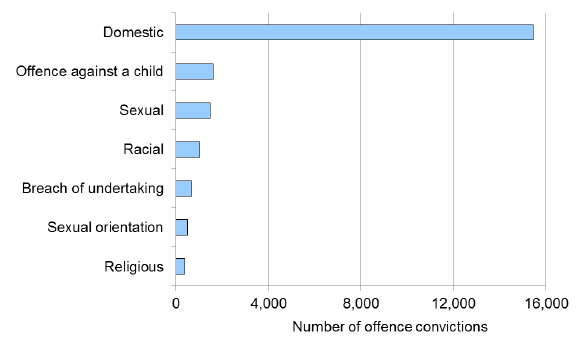CRIMINAL PROCEEDINGS IN SCOTLAND 2014-15
Summary of offences dealt with by courts, sentencing outcomes and characteristics of convicted offenders. Additional information on non-court penalties issued by the Police and Crown Office & Procurator Fiscal Service.
This document is part of a collection
12. Aggravators
This section has been included in the bulletin for the first time this year along with two tables on aggravators (tables 13 and 14). The tables were previously available as web only tables but have been brought into the publication to improve accessibility. Please note that statistics on bail aggravators, which identify offences that were committed while the offender was on bail, are not included in this publication but are available for download from the “Additional data” page.
Aggravator codes can be recorded on the Criminal History System (CHS) to provide additional information relating to the nature of a charge. For example, someone who commits an assault which is motivated by malice towards the victim as a result of their religion might have their offence recorded under “common assault” with an aggravator code of “religious” hatred.
The set of aggravator codes that are used on the CHS include those introduced through legislation, such as the religious or racial aggravators, and others which are not legislative aggravators, such as domestic abuse, but for which codes or identifiers are used to highlight and identify particular cases to the police, COPFS or SCTS. For the purposes of these statistics the term aggravator is used collectively for both types. A list of the aggravators introduced through legislation is presented in Annex C.
Statistics on aggravators
Please note that statistics on aggravators differ from most of the statistics in this bulletin in that they relate to all offences not just the main charge relating to an individual proceeding. In addition, a single offence can have more than one aggravator recorded against it e.g. “domestic” and “sexual” so the aggravator statistics are not a direct subset of our statistics at person level.
There were 21,862 offences with a charge proved with an aggravator recorded in 2014-15. The majority of these were for offences with a domestic abuse aggravator (15,452 or 71 per cent of all aggravators). The most common remaining aggravators were:
- Offences against a child aggravator, 7 per cent or 1,604 offences;
- Sexual aggravator, 7 per cent or 1,478 offences;
- Racial aggravator, 5 per cent or 1,030 offences.
Chart 11: Most common offences with a charge proved with an aggravator recorded, 2014-15

In 2014-15 there were 15,452 convictions for offences with a domestic abuse aggravator. The most common offences are as follows:
- Breach of the peace, which made up 46 per cent of domestic abuse offences with a charge proved (7,052 offences). The vast majority of these (96 per cent or 6,779 offences) were for offences of “threatening or abusive behaviour” or stalking.
- Common assault (29 per cent or 4,410 offences); and
- Crimes against public justice (14 per cent or 2,184 offences).
In 2014-15 there was a 14 per cent increase in the number of offences with a charge proved with a domestic abuse aggravator (15,452), up from 2013-14 (13,570 offences). This is the 4th consecutive annual increase with levels now 49 per cent higher than in 2010-11 (10,340 offences). Elsewhere in this publication, increases in convictions in 2014-15 can be seen for the most common offences related to domestic abuse. This is of particular note for the breach of the peace category, which accounted for two thirds of the annual increase for offences with a domestic abuse aggravator recorded. As outlined above these are mostly offences of “threatening or abusive behaviour” or stalking.
The increase may be reflective of a strengthened emphasis on tackling domestic abuse in Scotland by both Police Scotland and the COPFS. Please note that the increase does not necessarily mean that domestic abuse is occurring at a greater level than in previous years but may be due, in part, to improvements in the recording of domestic abuse cases on the CHS.
Contact
Email: Gillian Diggins
There is a problem
Thanks for your feedback